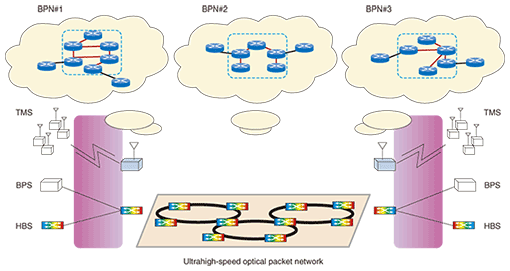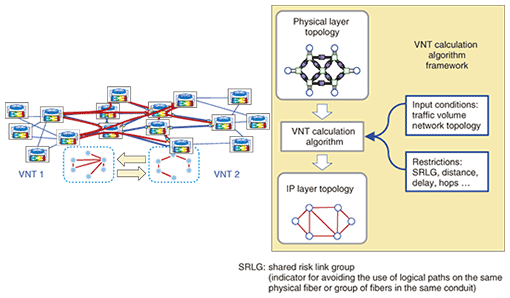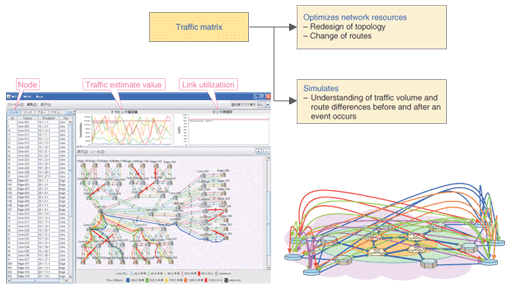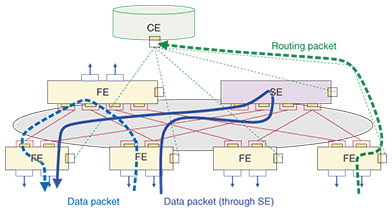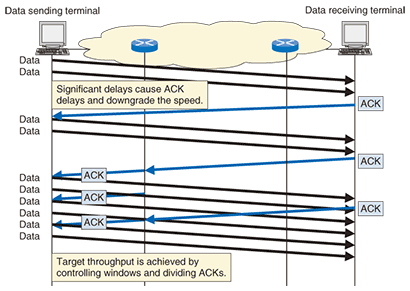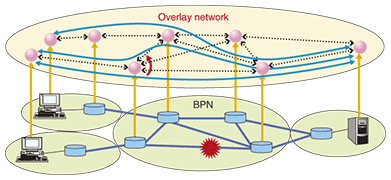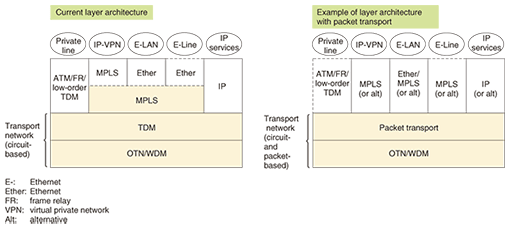 |
|||||||||||||||||||||||||
|
|
|||||||||||||||||||||||||
|
Special Feature: Design Concepts for New Generation Carrier Networks Vol. 7, No. 5, pp. 41–48, May 2009. https://doi.org/10.53829/ntr200905sf4 Toward a New Paradigm for Packet ServiceAbstractIn this article, we describe network virtualization and autonomic management & control, which are the basic technologies needed to provide various packet services efficiently on an ultrahigh-speed optical packet network. We also discuss (1) methods of achieving IP (Internet protocol) services, (2) the overlay network technique, which will stimulate new applications on the packet network, and (3) the trends in packet transport technology, which will provide carrier-grade broadband packet service.
1. IntroductionWith the explosive growth of the Internet, the amount of traffic has been increasing by a factor of 1.5 every year [1]. To keep up with the continuous increase in traffic, NTT Laboratories has been striving to research and develop an ultrahigh-speed optical packet network (hereinafter, UOPN in this article) [2]. Our aim is to provide various services on it, such as a huge-bandwidth service (HBS), broadband packet service (BPS), and tiny-bandwidth mass service (TMS) [3]. To provide these different types of services efficiently, we must configure various service networks on the UOPN, including a huge-bandwidth service network and a broadband packet network (BPN) and an event processing network (EPN) to handle event information to support TMS. A BPN supports various packet services (both BPS and conventional IP services) as well as the EPN on top of it [4]. Therefore, it is necessary to construct multiple BPNs to support various types of services. The BPNs for these different services are multiplexed on the UOPN, as shown in Fig. 1. In the future, as technologies advance, more applications are expected to be developed. Some of them will become killer applications and we may face more drastic traffic increases than today, which will make it harder to predict traffic characteristics. Moreover, partially because they are likely to play a greater role in our daily lives, communication networks must be more resilient to disasters and failures.
Considering this background, NTT Laboratories has been researching and developing technologies that will enable the provision of BPNs that can handle traffic changes flexibly and will be highly resilient to failures and disasters. For these BPNs, network virtualization and autonomic management and control are essential technologies. We explain these technologies in this article. We also discuss (1) methods of achieving IP services on BPNs, (2) the overlay network technique, which will stimulate the rapid growth of various new applications on BPNs, and (3) the trends in packet transport technology, which will provide carrier-grade BPNs. 2. Network virtualizationIn this article, we use the term network virtualization for technology that provides various service networks by virtually dividing and combining the resources of the UOPN (Fig. 1). When BPNs are provided as a service network, the service network can be made more flexible and resilient by combining network virtualization and autonomic management & control. BPNs are multiplexed on the UOPN. Layer 1 (L1) paths, which are provided by the UOPN, create links between routers, which are network nodes forming BPNs. The topology of the logical BPNs is configured by combining L1 paths. It is called the virtual network topology (VNT) [5]. The VNT is computed to suit a given traffic volume on a service network and UOPN resources taking into consideration restrictions on network operating policies, such as desired reliability and quality (Fig. 2).
Individual service networks can be designed easily by constructing BPNs to suit the quality and characteristics of each service. The BPN’s physical resources (e.g., routers) can be virtually divided and integrated and used to establish a BPN for an individual service. We call these routers logical routers. Router functions are segmented into components, and only necessary functions are provided to each BPN. This enables resources to be allocated flexibly. Network virtualization makes it possible to provide just the required functions when they are necessary by modularizing the BPN router resources and the UOPN resources. For example, when the BPN of a certain service is configured, a suitable network topology is dynamically configured by considering the traffic volume and the desired delay levels and other attributes needed to provide that service. Thus, BPNs can be logically configured without any physical restrictions. Network virtualization also makes it possible to access the resources of the UOPN, including wavelength links that connect nodes of the optical transport network, as multiple BPNs by dividing those resources in a virtual manner [6]. When the UOPN resources are divided into multiple BPNs, the contention between multiple BPNs is also adjusted. In this case, BPNs are configured by dividing UOPN resources according to the quality and characteristics of the services on each BPN. 3. Autonomic management and controlAutonomic management and control is a technology that manages dynamic network traffic changes that cannot be predicted at this moment and it strengthens network resiliency against failures and disasters. This technology upgrades the maintenance functions of a virtualized network through automatic failure recovery and congestion control. It enables the traffic volume on a virtualized network to be measured automatically and resource utilization of the whole network to be optimized in real time. It also provides congestion control for responding to changes in traffic automatically: the network traffic volume is automatically measured, and if the volume exceeds a threshold, a new link is dynamically set up to carry the traffic while the VNT is altered, if possible, to reduce the traffic volume carried by the congested link. Although a route is automatically changed to a recovery route if a failure or disaster occurs, the VNT is changed automatically depending on how much the total network resources could be reduced by a failure or disaster, and the resources are reoptimized. The operator also can start VNT optimization manually when necessary. The key points of autonomic management and control are to measure the traffic volume and optimize network resources considering the volume in real time. Since it is actually difficult to measure the traffic volume of a large-scale network in real time, there is no alternative but to measure it under some restrictions. Thus, given that the traffic volume will be measured under some restrictions, the challenge is to predict the status of the whole network accurately enough that network resources can be optimized. For this purpose, the traffic volume of the whole network (i.e., traffic matrix) is estimated on the basis of information about traffic on the links between routers, and resource optimization should then be conducted (Fig. 3).
In addition to detecting what is happening in the different parts of the network and performing autonomic control, the system must also deliver the information to the operators in a clear manner. Moreover, it is important to simulate what will happen after autonomic control is applied and to deliver the results to the operator before autonomic control is performed so that the operator can make the correct decisions. To deliver the network status to the operator clearly, it is effective to visualize the network traffic volume and route statuses as well as the network status after an event occurs. 4. IP services on BPNsExisting IP services also need to be provided as a service network on the UOPN. One of the advantages of using BPNs on the UOPN to provide IP services is the availability of the cut-through technique. If the traffic on a BPN suddenly surges and a large amount of traffic flows between certain BPN end points, it is effective to set up a dedicated wavelength path that directly connects those end points via cut-throughs at intermediate routers. The VNT determines whether or not to dynamically configure a lightpath and to set cut-throughs by considering the traffic carried by the IP network. A technology that provides scalable and flexible IP services on BPNs is functionally distributed transport [7]. This can divide forwarding elements (FEs), which transfer packets, and service elements (SEs), which provide services with added value, from control elements (CEs), which provide route calculation. This division lets us enhance each element separately (Fig. 4).
With functionally distributed transport, FEs, CEs, and SEs can be integrated effectively and nodes can be configured flexibly. Each node can also be provided to each service network after resources have been divided by considering each node as a logical router. The number of nodes in a BPN can be adjusted by setting nodes of different sizes. BPNs require route calculation that permits dynamic cut-through by lightpaths. Furthermore, they require route calculation on a network that supports a vast number of terminals including objects—a trend being driven by the development of ubiquitous services such as TMS. Here, configuring nodes of the right size in suitable numbers will be an effective way to reduce the calculation overhead. To better support the current versions of high-layer protocols, such as TCP (transmission control protocol), a more-efficient upper-grade transfer function will also be needed. Even if a lightpath is set up in response to a traffic increase, the current version of TCP suffers from poor flow control. Thus, a TCP transfer control method suitable for optical high-speed networks needs to be considered. Techniques such as updating TCP windows from the network side and controlling the timing of acknowledgments (ACKs) will be effective ways to achieve the target throughput (Fig. 5) [8]. Those functions specific to special services can be achieved as SE functions in functionally distributed transport. The SE function is also effective in designing the overlay network, which provides value-added services for each application.
5. Overlay networkIf the functions offered by the BPNs, including quality of service (QoS), mobility, and security functions, are utilized, then it is likely that killer communication services will emerge with the provision of many new applications having higher quality and security that are impossible to provide over the current Internet. The overlay network (Fig. 6) is expected to foster the emergence of killer communication services. Communication services are provided by applications implemented on the end hosts. The overlay network technique can flexibly set up communication paths between end hosts provided by BPNs, taking into account the state of the network as an upper layer of the transport network. The end hosts running applications organize overlay network topologies. For example, by using the quality-guaranteed communication paths provided by the BPNs, they can organize the overlay network and establish multicast delivery of high-quality images on it.
The overlay network can also be used to control network traffic. Network resources can be utilized efficiently by considering changes in the network’s status and traffic. If either the BPNs or the UOPN, which is the lower-layer network, experiences a drop in quality and/or reliability, the overlay network can respond by changing individual topologies set between terminals or by rerouting traffic along better routes. 6. Packet transportIn BPN configuration, the packet transport method is considered to be a new technology that can provide paths whose quality matches those of existing transport networks. We call this new technology the new packet transport technology. Candidates for new packet transport technologies include PBB-TE (provider backbone bridge traffic engineering) [9] and MPLS-TP (multiprotocol label switching transport profile) [10]. This new packet transport technology is expected to simplify layers and network design (Fig. 7).
ATM (asynchronous transfer mode), MPLS, and IP networks were all designed to provide various services on top of circuit-switching-based transport networks such as TDM (time division multiplexing) and OTN/WDM (optical transport network, wavelength division multiplexing). However, the introduction of the new packet transport technology enables fine-grained bandwidth paths to be set up on the transport network. Supporting various bandwidths and signal rates in one device may enable reductions in the numbers of devices and layer levels. Another feature of the new technology is that it supports packet services well as a result of its packet multiplexing. Moreover, because the transport network will, fundamentally, offer packet switching, it may be possible to reduce the number of core nodes in the service network. For the new packet transport technology, it will be important to achieve OAM (operation, administration and maintenance) functions, QoS functions, and scalability in terms of the number of paths while taking advantage of the characteristics of the current packet switching. Another point is that packet protocols should be designed using a clean-slate approach considering that the network will act as a social infrastructure [11]. It is important to provide sufficient space to permit protocol extensions in the future by designing them while bearing in mind aspects points such as QoS, mobility, and security. 7. Concluding remarksIn this article, we explained network virtualization and autonomic management & control as basic technologies for providing various packet services efficiently. We also discussed the trends in packet transport technology, which will yield a carrier-grade broadband packet service, the overlay network technology, which allow new applications to emerge quickly on the broadband packet network (BPN), and methods of achieving IP services on BPNs. In addition, we introduced technology components. Some of these still have issues that need to be resolved before we can make the future network. We will continue our research and development activities in order to find detailed solutions. AcknowledgmentPart of our research on functionally distributed transport is supported by the National Institute of Information and Communications Technology (NICT). References
|
|||||||||||||||||||||||||








